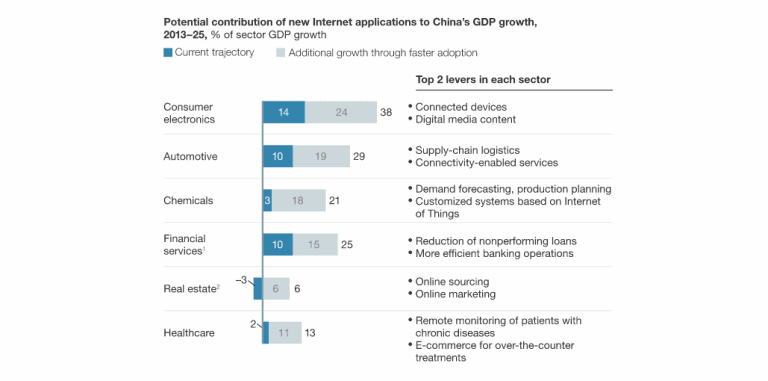Comprehensive Guide to eCommerce in China: Top Chinese eCommerce Platforms
Looking to tap into the booming Chinese market? Well, you’re not alone. As experienced marketers, we’ve also faced the challenge of understanding and navigating the world of Chinese ecommerce platforms. But fret not – we’ve done our homework and found a goldmine of information that will help you conquer this hurdle.
In this article, we’ll explore everything you need to know about Chinese ecommerce platforms and how to succeed in this lucrative market. Get ready for some eye-opening insights!
Chinese E-commerce Market Overview
Notably, China holds a staggering 50 percent chunk of the globe’s e-commerce transactions, proving its colossal role in global retail. The importance and relevance of the Chinese market cannot be overstated when crafting an effective global marketing strategy; it has completely revolutionized traditional retail for both sellers and buyers alike.
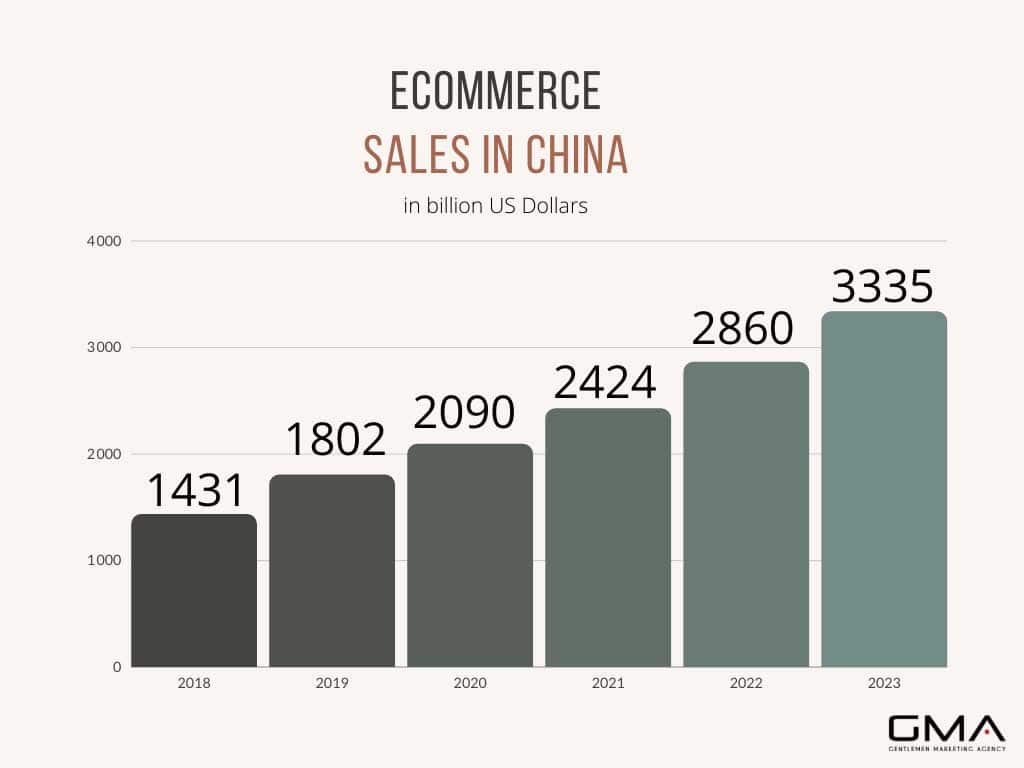
Currently, China stands as the largest e-commerce market globally with a staggering market size that’s twice as large as its closest competitor – the United States, projected to reach $1.556 trillion in 2024, an impressive 80% growth from $862 billion in 2019.
But it’s not just about economic figures or consumer numbers – consider also China’s robust logistics infrastructure, a key component driving this sustained growth and success. Companies like Alibaba and JD.com are shining examples influenced by these supportive factors.

Top Chinese E-commerce Platforms
When it comes to the popular Chinese eCommerce platforms, there are many to chose from, depending on your goals, target audience and budget. We will list some of the most popular below, so that you get an idea of how the landscape among big Chinese eCommerce platforms looks like.

Taobao (淘宝)
The Chinese Ecommerce market is full of potential, with Taobao (淘宝) paving the way. Owned by industry giant Alibaba Group and founded in 2003, it exemplifies growth and success in this digital age, quickly rising to become the nation’s largest consumer e-commerce platform.
Taobao stands as a beacon for small businesses and individual entrepreneurs, offering them an opportunity to open online stores on its wide-reaching platform. Its position as a C2C marketplace has solidified over time due largely to the trust that Chinese consumers place in it.
They appreciate its wide range of product offerings and competitive pricing – factors that contribute significantly to Taobao’s strong presence within China’s online shopping industry.
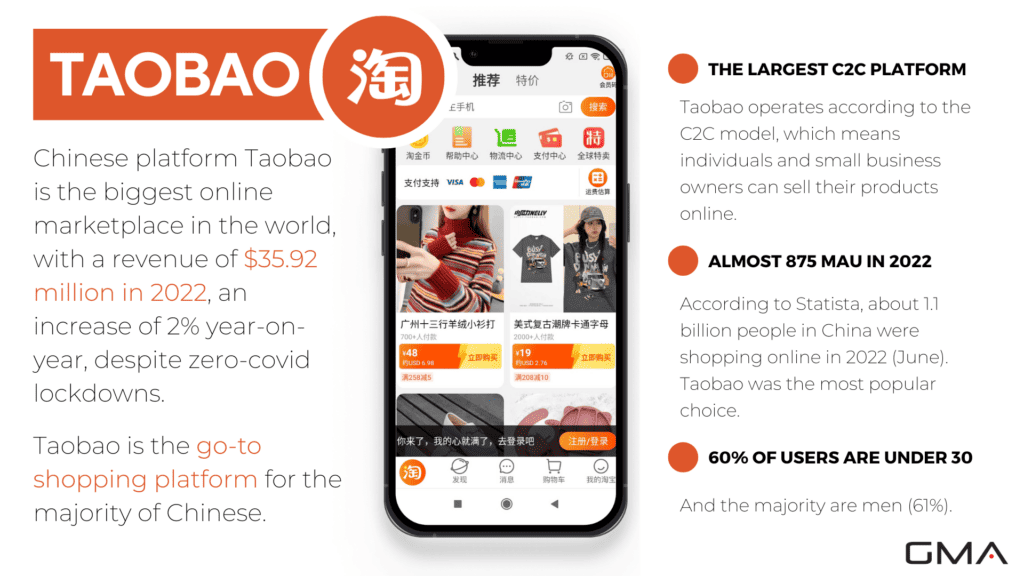
This strategic advantage doesn’t stop at local borders; Taobao extends its outreach globally by providing English language support. The demographic target isn’t confined either; both young and old consumers are catered for equally on this robust platform.
Another pioneering aspect: live commerce– combining entertainment with instant purchasing- is fast becoming a trendy channel on platforms like these.
Taobao is best for companies that have a Chinese business license and are willing to enter the market “from the inside”. Everyone can sell there, which means there is a huge compatition from local brands, so you will need a good, omnichannel strategy to succeed.
Tmall (天猫)
You’ll definitely want to pay attention to Tmall (天猫), one of the top Chinese e-commerce platforms owned by Alibaba. With over 700 million registered customers and more than 50% market share in China’s B2C e-commerce business, Tmall is a powerhouse.
It caters primarily to consumers in mainland China and offers a wide range of products and brands, making it popular among both local Chinese and international businesses. Particularly renowned for its beauty and fashion offerings, Tmall provides an extensive customer base and a seamless shopping experience for consumers.

If you’re looking to enter the Chinese market or expand your brand’s reach in China, exporting through Tmall or its cross-border e-commerce platform Tmall Global could be an excellent strategy. Its success can be attributed to its strong customer engagement capabilities and effective business model. But it comes with a cost, because it’s very pricey, and only well-known brands are invited to the platform.
JD (京东)
Entering the online market scene in 2004, JD has grown into a massive B2C retailer with an impressive footprint that appeals greatly to both local and international brands aspiring to make their mark among Chinese consumers online.
What sets it apart from other top Chinese e-commerce platforms is its comprehensive suite of services designed specifically for navigating the dynamic needs and preferences inherent in different sectors and regions within China’s vast consumer market.

Given its reliable service quality coupled with significant traffic volume, JD boasts a broad demographic appeal unrivaled by many competitors. This robust presence across the entire spectrum of e-commerce makes it an ideal partner for your brand as it ventures into this promising landscape teeming with opportunities.
Douyin (抖音)
Owned by ByteDance, Douyin is often compared to TikTok but with a distinct focus on the Chinese market. It is ranked among the top three platforms for online sales in China and boasts over 600 million daily active users.
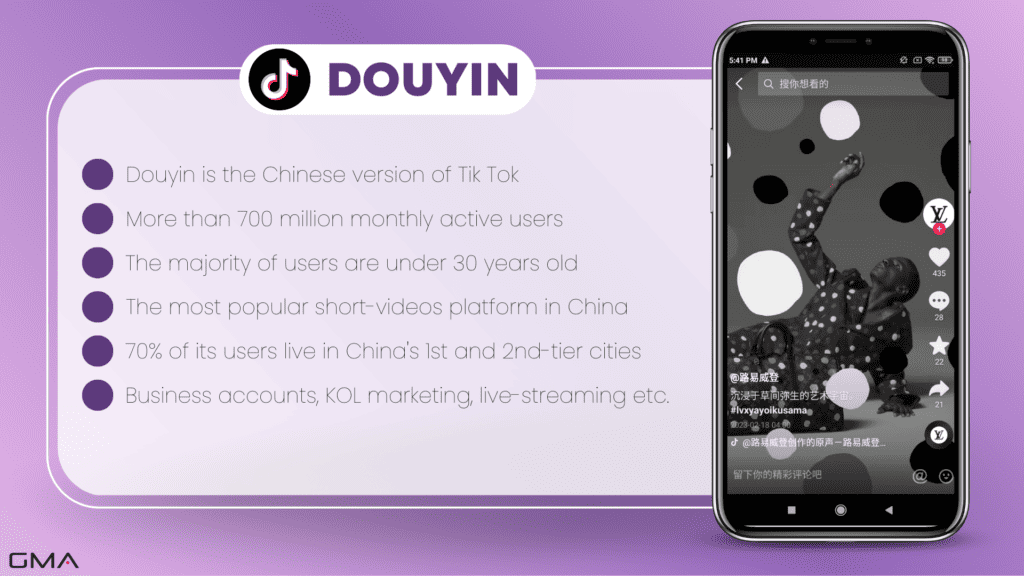
This unique short video app combines social media engagement, digital advertising, and online shopping all in one platform. It’s not surprising that Douyin has become a favored strategy for digital marketers looking to reach China’s fast-rising affluent class.
In fact, many US brands have found success on Douyin as it provides access to Generation Z, millennials, and other demographics through its emphasis on e-commerce integration. Moreover, its popularity makes it an ideal platform for influencer marketing campaigns where brands can leverage KOLs (Key Opinion Leaders) and influencers to connect with Chinese consumers effectively.
Pinduoduo (拼多多)
Pinduoduo is a rising star in the Chinese e-commerce market, offering discounted products and affordable options for price-conscious consumers. Founded in 2015, this e-commerce platform has quickly gained popularity by targeting China’s forgotten shoppers who are looking for budget-friendly deals.

Pinduoduo stands out with its unique business model centered around group buying deals, allowing users to join forces and unlock better discounts together. With rapid growth and a large customer base, Pinduoduo has become the third-largest e-commerce platform in China.
Its success showcases the potential for small brands to thrive on the platform and reach a wide audience. Additionally, Pinduoduo’s focus on agricultural products indicates its strong presence in the grocery sector, making it an attractive option for retailers seeking to tap into this segment of the Chinese market.
WeChat Stores
WeChat is a powerhouse social media platform in China. With over a billion monthly active users, WeChat offers an immense opportunity to reach a vast audience.
What makes WeChat particularly valuable for e-commerce platforms in China is its robust ecosystem for brand launches. By utilizing the Mini-Program feature on WeChat, businesses can create their own stores within the app, providing a seamless and convenient platform for online shopping.

In fact, WeChat stores are associated with top Chinese e-commerce platforms like Douyin and Weibo. These stores cater to Chinese users who embrace capitalism and appreciate businesses that actively market themselves on social media.
Key Trends in the Chinese E-commerce Market
Shopping festivals, online and offline integration, social media, and e-commerce integration, livestream shopping, the rise of group buying, sustainability and ethical consumerism, influencers (KOLs), and key opinion consumers (KOCs).
Shopping Festivals
Shopping festivals are a key trend in the Chinese e-commerce market, providing immense opportunities for businesses to boost their sales and gain brand recognition. China is known for hosting some of the largest online shopping events in the world, such as the 6.18 Mid-Year Shopping Festival and Chinese New Year festivities.
During these events, major e-commerce platforms like JD.com and Taobao offer significant discounts and promotions to entice online shoppers.

These shopping festivals have become an integral part of Chinese consumer culture, with billions of RMB Renminbi worth of goods sold each year. For foreign businesses looking to tap into the lucrative Chinese retail market, participating in these events can be highly rewarding.
Not only do they provide a platform to showcase products to a wide customer base, but they also create incentives for online shoppers to make purchases.
Online and Offline Integration
In the fast-paced world of Chinese e-commerce, online and offline integration has emerged as a key trend. This means that traditional brick-and-mortar retailers are finding ways to seamlessly link their physical stores with their online platforms, creating a cohesive shopping experience for consumers.
The concept was pioneered by Alibaba through its New Retail strategy, and it has since gained significant traction in China’s booming e-commerce market. By integrating both online and offline channels, businesses can provide customers with a seamless shopping journey where they can research products online before making purchases in-store or vice versa.
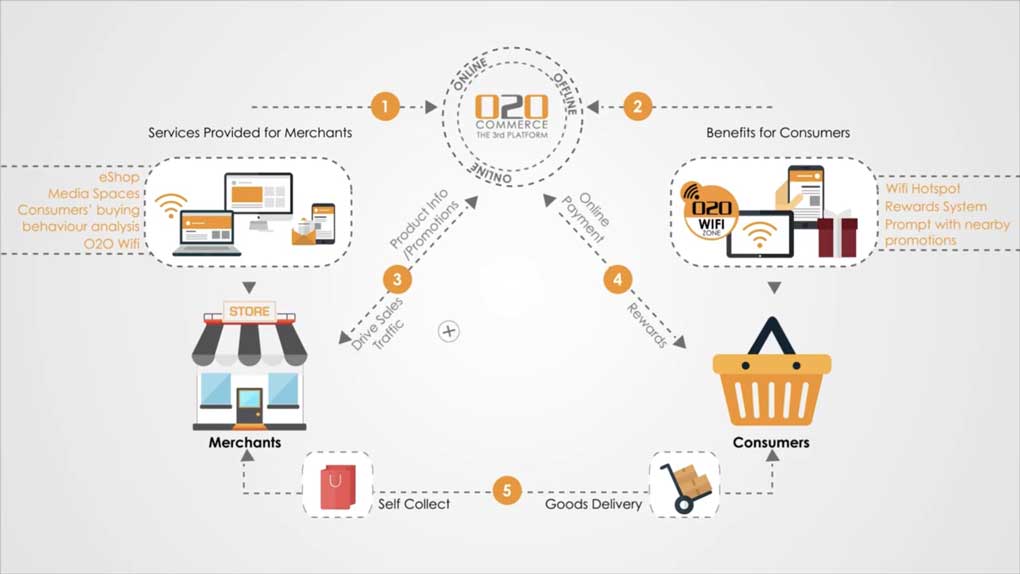
This not only enhances convenience but also allows retailers to collect valuable data on consumer behavior across different touchpoints. Online and offline integration is an essential aspect of capturing the attention and loyalty of Chinese consumers in today’s digital landscape.
Social eCommerce: Social Media and E-commerce Integration
Social media and e-commerce integration is a key trend in the booming Chinese e-commerce market. Platforms like WeChat, Sina Weibo, and Douyin not only serve as social networking sites but also offer unique features that facilitate online shopping and engage users.
In fact, social commerce makes up a significant portion of China’s retail sales, accounting for 11.6% of the country’s total. By harnessing the power of social media marketing activities on these platforms, businesses can tap into a vast customer base and drive sales.
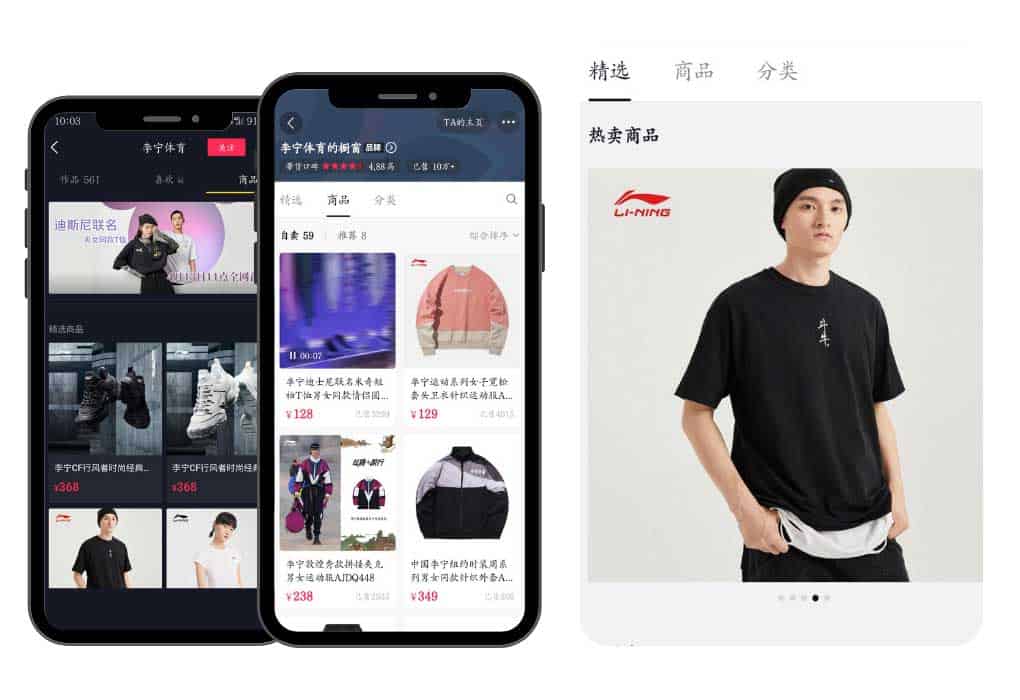
Key opinion leader (KOL) live-streaming has emerged as an effective strategy to showcase products and influence purchasing decisions. All those platforms also offer integrated online malls, providing the best shopping experience for its users.
As China’s e-commerce market continues to grow rapidly, it presents immense opportunities for brands looking to leverage social media platforms for marketing, sales, and customer engagement.
Livestream Shopping
Livestream shopping is all about creating an engaging and entertaining environment for consumers while providing them with real-time access to products and services. In China, live-streaming has become a massive industry in itself, generating billions of dollars in sales.
It’s no wonder that Alibaba, the Chinese retail giant, pioneered this concept by linking online livestream broadcasts with e-commerce stores. By combining entertainment, social interaction, and convenience, livestream shopping creates a more immersive experience for buyers while allowing brands and retailers to showcase their products in an authentic way.
The success of livestream shopping speaks for itself – it’s now one of the most prevalent trends in East Asia, with projections estimating its market size to reach billions of dollars in the coming years.

Rise of Group Buying
Group buying has emerged as a major trend in the Chinese e-commerce market, revolutionizing online shopping habits. In this unique phenomenon, communities come together to leverage their collective purchasing power and score massive discounts on products and services.
Local leaders play a crucial role in coordinating these group purchases, making it not only an efficient way to shop but also a social experience. This innovative approach has transformed the way people buy online in China, with significant implications for both consumers and businesses alike.

With community-driven group buying projected to continue growing at an impressive rate of 13.2% in 2021, it is clear that this trend is here to stay. As marketers, understanding and tapping into the world of group buying can provide exciting opportunities for reaching new customers and driving sales in the Chinese market.
Sustainability and Ethical Consumerism
With over 90% of Chinese shoppers expressing interest in sustainable products, there is a significant market for businesses in the eco-friendly product sector.
This presents an opportunity for brands offering sustainable fashion and other environmentally conscious products to tap into the growing demand among young, urban consumers in China.
Chinese e-commerce platforms like Pinduoduo are actively working towards sustainability and have created an omnichannel shopping ecosystem that allows customers to make more informed choices about green brands and imported products with better ethical standards.
Moreover, given that almost 50% of global transactions take place in China, online platforms provide wide exposure for these sustainable brands looking to expand their reach within the Chinese market.

Influencers (KOLs) and Key Opinion Consumers (KOCs)
Influencers, also known as Key Opinion Leaders (KOLs), play a crucial role in the Chinese ecommerce industry. These influencers collaborate with brands to promote their products or services through celebrity endorsements or social media platforms like WeChat, Weibo, and Little Red Book.
KOL marketing in China has gained immense popularity due to the engagement and relationship-building between influencers and their followers. It is predicted that influencer marketing will become even more effective in 2023, with micro-influencers on the rise.
In addition, brands are utilizing Key Opinion Consumers (KOCs) and private spheres like WeChat Moments pages to reach their target audience effectively. Understanding the difference between KOCs and KOLs is essential for success in the Chinese market, where influencer marketing trends continue to evolve year after year.
Benefits and Challenges of Selling on Chinese E-commerce Platforms
Selling on Chinese e-commerce platforms offers many opportunities to local and foreign brands, but it also commes with many challenges. Let’s dive in!
Benefits of selling on Chinese eCommerce platforms
- Access to a Wide Customer Base: By selling on Chinese e-commerce platforms, businesses can tap into China’s vast customer base, which accounts for almost 50% of the world’s online transactions.
- Increased Market Reach: With China being the largest e-commerce market in the world, businesses can enhance their international market penetration and potentially increase sales by 20%.
- Improved Brand Exposure: Utilizing popular Chinese e-commerce platforms can significantly boost brand visibility among millions of daily users. Leveraging social media integration and partnerships with Key Opinion Leaders (KOLs) can further enhance this exposure.
- Opportunities in Cross-border E-commerce: Platforms like Tmall and JD.com allow businesses to reach Chinese consumers directly without the need for physical stores or local distribution networks. This approach has been highly profitable, with cross-border imports and exports reaching a total of RMB 1.98 trillion in 2021.

- Understanding Regional Differences: The regional variances across China mean diverse consumer preferences. Understanding these differences allows businesses to tailor their marketing strategies and product offerings to each target audience, enhancing appeal and sales potential.
- Potential for Partnerships: Selling on Chinese e-commerce platforms opens up opportunities for partnerships with influential Chinese companies and KOLs. Such alliances can provide local market insights, distribution channels, and resources to navigate the complex regulatory environment, while also increasing brand exposure and driving sales.

Challenges of Selling on Chinese E-commerce Platforms
- Understanding Cultural Differences: The Chinese market has unique social norms and consumer preferences that differ from Western markets. Recognizing these differences can allow marketers to tailor their strategies effectively for the Chinese audience.
- Overcoming Language Barriers: Mandarin Chinese is the primary language in China, and understanding it is crucial for successful communication. Overcoming language-related hurdles requires strong language and translation skills, as well as effective localization efforts.
- Intellectual Property Protection: China has had issues with intellectual property theft, including brand stealing and counterfeiting. However, laws have been implemented to address this, and e-commerce platforms have measures in place to verify the authenticity of merchants. Awareness of these risks and taking necessary precautions are essential for selling on Chinese platforms.

Tips for Success on Chinese Ecommerce Platforms
Localize your marketing strategy to resonate with the Chinese audience, understand their preferences and cultural nuances, optimize your listings for visibility, provide excellent customer service to build trust, continuously monitor and adapt to market trends, utilize local digital marketing tools such as WeChat and Douyin for targeted advertising, and focus on developing relationships (Guanxi) with potential partners or influencers.
Localize Your Marketing Strategy
To succeed on Chinese ecommerce platforms, it’s crucial to localize your marketing strategy. This means tailoring your approach to the unique needs and preferences of the Chinese market. One essential aspect of localization is implementing effective international SEO strategies that will help boost your visibility and attract local consumers.
Another key consideration is building trust with Chinese consumers, who value authenticity and reliability when making online purchases.
Understanding Chinese consumer behavior is also vital in crafting a localized marketing strategy. By adapting your messaging and campaigns to align with the cultural customs and way of life in China, you can better resonate with your target audience.
Additionally, having a strong social media presence in China is important as these platforms play a significant role in driving ecommerce sales.

Understand Your Target Audience
Chinese online shoppers have unique preferences and behaviors, and catering to their needs requires a deep understanding of their wants and desires.
This involves conducting thorough research on consumer habits, cultural nuances, and preferred shopping platforms. By gaining insights into what motivates your Chinese customers, you can tailor your marketing strategy to resonate with them effectively.
This includes adapting your product offerings, messaging, and customer service to align with the specific tastes and expectations of your target audience in China’s dynamic e-commerce landscape.
Optimize Your Listings
Research shows that products with well-optimized listings tend to receive higher click-through rates and conversion rates.
When optimizing your listings for Chinese e-commerce platforms, it is important to understand the preferences and search behavior of Chinese consumers. Conducting market research and analyzing competitor listings can provide valuable insights into effective keyword selection and content optimization strategies.
By understanding common search terms used by Chinese consumers, you can tailor your product descriptions accordingly.

Additionally, it is essential to use high-quality images that showcase your products in the best light. In China’s competitive e-commerce landscape, visually appealing images are more likely to attract attention and generate interest from potential buyers.
Utilizing professional photography or graphic design services can help create enticing visuals that appeal specifically to the tastes of Chinese consumers.
Provide Excellent Customer Service
Chinese consumers prioritize satisfaction and expect top-notch service from online retailers. By understanding their behavior and meeting their expectations, you can significantly increase your chances of success in the Chinese market.
Chinese consumers appreciate the personalized attention and prompt responses to their inquiries or concerns. They value transparency and trustworthiness, so having clear policies regarding shipping, returns, and refunds is essential.
Offering an easy returns policy within seven days of purchase is particularly important as it aligns with local customs and increases consumer confidence.
To provide exceptional customer service on Chinese ecommerce platforms, it’s vital to have a strong social media presence where you can interact with your customers directly. Engaging with them regularly through platforms like Weibo or WeChat helps build relationships and foster loyalty.
Moreover, targeted marketing campaigns that resonate with Chinese shoppers will yield better results. It’s essential to understand cultural nuances and tailor your messaging accordingly. Conducting consumer behavior analysis specific to the Chinese market can provide valuable insights into what drives purchasing decisions.

Utilize Local Digital Marketing Tools
China has a unique digital ecosystem with platforms like WeChat, Douyin (China’s version of TikTok), and Weibo that dominate social media channels.
These platforms offer targeted advertising options, influencer partnerships, and innovative marketing features such as live-streaming shopping.
In addition to social media, search engine optimization (SEO) should be a priority on popular Chinese search engines like Baidu, which has its own advertising platform called Baidu Tuiguang.
Utilizing keywords relevant to your target audience will help improve visibility in search results.
Email marketing may not be as prevalent in China compared to other countries; however, mobile messaging apps like WeChat can serve as an alternative for direct customer communication and engagement.
Building strong relationships with customers through personalized messages and promotions can lead to increased loyalty and brand awareness.
Another important aspect of local digital marketing in China is understanding the country’s payment landscape. Mobile payment platforms such as Alipay and WeChat Pay dominate the market, making it crucial for businesses to integrate these payment options into their ecommerce websites or apps.
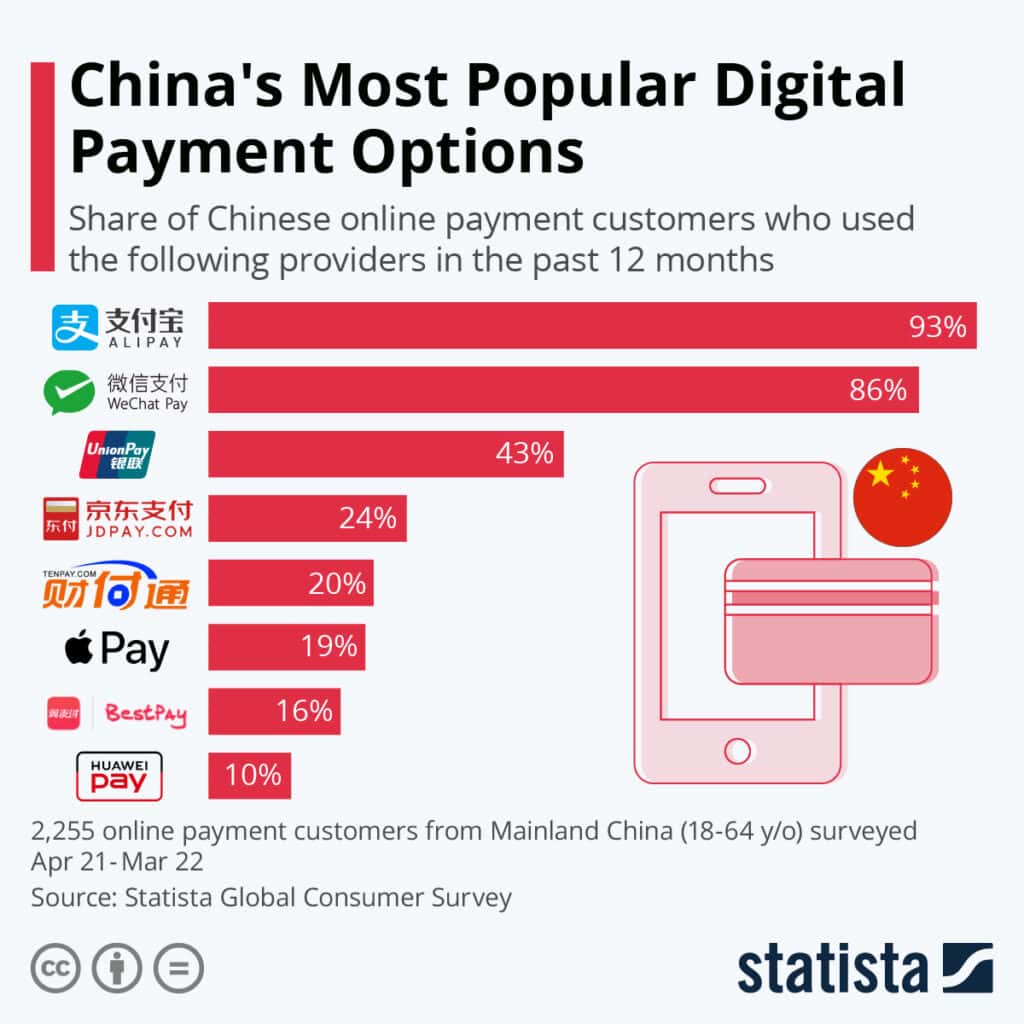
Developing Relationships (Guanxi)
When selling on Chinese ecommerce platforms, developing relationships (guanxi) is crucial for success. Guanxi refers to the art of building and maintaining relationships based on reciprocity, which is highly valued in Chinese society.
It involves understanding China’s culture and social networks, as well as forming influential connections that can provide special favors. Building guanxi requires a long-term approach and a genuine effort to establish trust with individuals and organizations.
On Chinese ecommerce platforms, where trust and relationships are highly valued, investing in guanxi-building efforts can greatly contribute to business success. By understanding the significance of guanxi in Chinese culture and leveraging it effectively, marketers can navigate these platforms more effectively and forge stronger connections with customers and business partners alike.
Case Studies of Successful International Brands in Chinese Ecommerce
Expanding into the Chinese e-commerce market offers unique opportunities and challenges. Several international brands have managed to penetrate this dynamic space successfully. Below are a few examples:
- Nike: Nike is a frontrunner when it comes to leveraging the power of Chinese e-commerce platforms. They tapped into the popular trend of live commerce, significantly bolstering their sales. Nike also partnered with Tmall to participate in their shopping festivals, further boosting their visibility and customer reach.
- Starbucks: Starbucks forged a strategic partnership with Alibaba, allowing it to integrate across Alibaba’s platforms. This move greatly increased Starbucks’ online presence and provided a seamless online-to-offline experience for its Chinese customers.
- Zara: Zara has made the most of its presence on Tmall by optimizing their product listings and providing excellent customer service. They’ve understood their target audience and localized their marketing strategy accordingly, leading to their success.
- Pampers: Pampers has been particularly successful on JD.com. Their success can be attributed to their localized marketing strategies and understanding of the Chinese consumer’s needs.
These brands show that understanding the market and adapting your strategy accordingly is the key to success in the Chinese e-commerce landscape. They demonstrate the opportunities that come with selling on Chinese e-commerce platforms, such as wide customer reach, brand exposure, and potential partnerships with Chinese companies and influencers.

We are Your Local eCommerce Agency in China!
Navigating through the intricate landscape of Chinese e-commerce platforms can be challenging. This is where our team at Gentlemen Marketing Agency can step in and help your business tap into this booming market. With our deep understanding of the Chinese e-commerce ecosystem and vast experience in digital marketing strategies, we can help your business reach its potential customers efficiently and effectively.

We specialize in setting up and optimizing store presences on major platforms like Taobao, JD.com, Tmall, WeChat Stores, Douyin, and Pinduoduo. From account setup to product listing, from localized marketing campaigns to customer service, we offer a full spectrum of services to ensure your venture in China is a success.
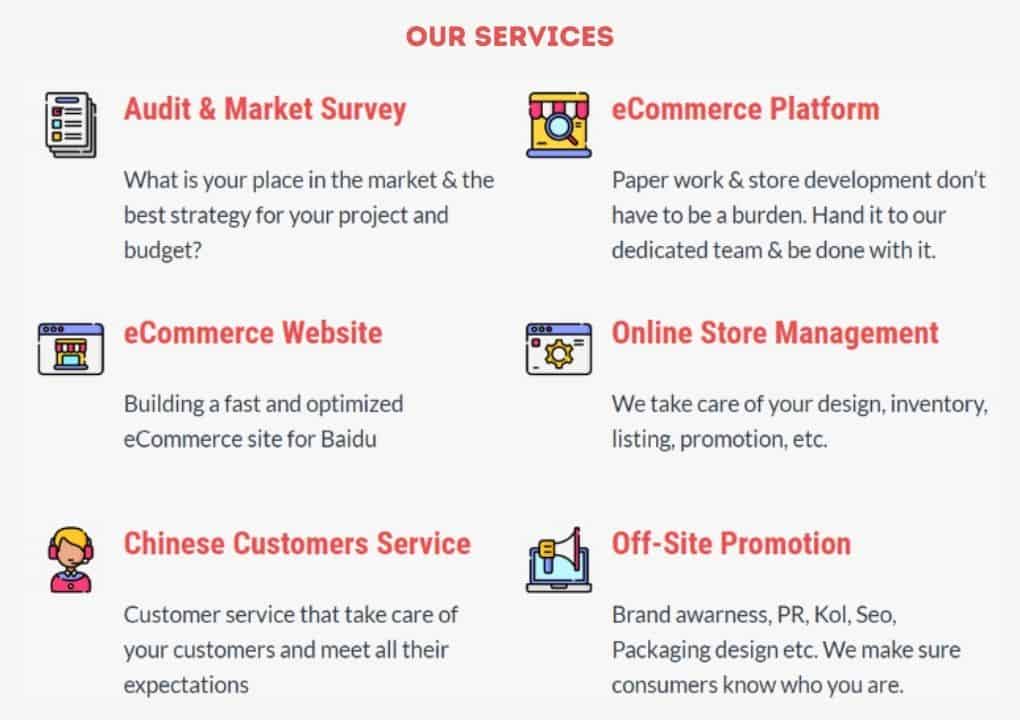
Partnering with us not only opens doors to the largest e-commerce market in the world but also provides you with expert insights into Chinese consumer behaviors, regional preferences, and trending products. Furthermore, our extensive network of Key Opinion Leaders (KOLs) can elevate your brand awareness among the Chinese audience to new heights.
Get in touch with us at Gentlemen Marketing Agency today. Let’s turn your vision for your brand’s growth in China into a reality!







